1:03.586S
92:06.61W
Friday
15th June - A Gallop through the Galapagos
Having recovered from the excitement of crossing the line on
7th June, we knew that we’d have to slow down if we were to enter the
anchorage at Academy Bay
on the island of
Santa Cruz in
daylight. The easiest way of doing
this was to take down the sails and potter along with a low revving engine. At about 0330 on Friday morning the
service alternator charging light on the engine panel lit up. That’s not helpful – it means that the
alternator isn’t charging the domestic batteries that run pretty well everything
on board. The only thing they don’t
do is start the engine. So, Mr
Perkins, precisely what is your problem?
Please do not tell me that either the service alternator or its regulator
has died. Removing the engine cover
revealed two very mangled alternator belts. We’d tightened them up before leaving
Panama but obviously hadn’t been
ruthless enough about it. So,
they’d worked slack, begun to slip and eventually expired. It’s a pretty big alternator they drive
so slack belts are not a good idea.
Well, we’ve got spare alternator belts and replacing them isn’t a major
drama – irritating though it may be.
However, in thrashing about the engine compartment the now dead belts had
managed to mangle and rip off the three wires to the oil pressure sensor. So, even though we could have survived
until we got to anchor without an alternator charging our domestic batteries,
the engine would not re-start as long as those wires were not connected. Hot-wiring might have been an option
provided you knew what you were doing – but at around 0400 that morning Jon
wasn’t up to thinking that one through.
Meanwhile, given that
it was dark, we were getting pretty close to the islands and there was quite a
lot of traffic around it didn’t seem wise to drift about unable to
manoeuvre. And, no, we don’t have
two red all-round lights to show our being ‘Not under command’. We rehoisted sail to give us the
manoeuvrability we needed and set off in the general direction of Academy Bay.
Meanwhile Jon went to work in the engine compartment with an electrical
crimping kit and lengths of spare wire.
After a bit of trial and error we managed to get the three wires
connected to the right terminals on the oil pressure sensor. It had proved impossible to tell by
examination which terminal was which on the sensor – buried as it is in the
depths of the engine. But, there
are only 6 permutations for 3 wires and 3 terminals and we managed to get it
right on the fifth attempt. Which,
one has to accept, is indicative of some pretty poor guessing. It may explain why we haven’t won the
lottery – although our lack of investment may have something to do with it.
The
church clock in Puerto Ayoro, the main town on Santa Cruz Island, and which
fronts Academy
Bay, was chiming 8 o’clock
as we anchored. We had about an
hour of rest before a water taxi came alongside and on board stepped Ivan. He was not the agent we had arranged to
deal with; he was in fact the agent’s friend’s husband! Sadly, he spoke less English than Carol
speaks Spanish and worse, he clearly wasn’t conversant with all the necessary
procedures. Nevertheless, he went
away with a large number of our dollars and passports. Later, he dragged us off to Immigration
who were a) shut because it was lunchtime and b) won’t deal directly with
punters – that is what the agent is
for! He did, however, find us a
welder who did work we needed to be done at a very reasonable rate.
A
couple of visits to very smartly dressed Fuerza Naval officials – how do they
manage to keep their uniforms so pristine? – brought a pleasant surprise. The harbour dues amounted to “only” $180
instead of the $315 that the agent had advised us they would be. This covered us for up to 20 days in the
Galapagos, but only in Puerto Ayoro.
If we had wanted to go to other islands, we understood that our agent’s
charges would have risen from a mere $150 to $400 to include the required
cruising permit. In addition, the
harbour authority in each harbour in which we dropped anchor would extract
another wad of dollars at least equal to the $180 we’d already paid the Ayoro
authority. Since we were only going
to be in the islands for a week and needed to be in the capital for several days
of that anyway to get stuff done and bought, that was rather more than we wanted
to pay.
Ayoro
harbour bay is dotted with local tourist boats – some definitely more upmarket
than others – so they should be at a price tag of up to $5-6000 per head per
week – cruising yachts and working boats that service the supply ships. Little yellow water taxis buzz around
taking everyone hither and thither.
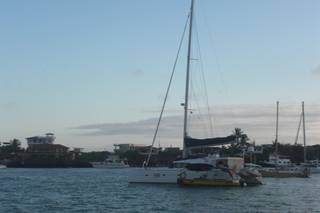
For the first few
days, Arnamentia’s decks resembled Steptoe’s back yard as everything from
the forepeak and the lockers therein, was brought up on deck to dry, following
the ingress of a fairly substantial amount of water on the passage from
Panama. That had been the result of having
lowered the staysail to the bottom of the inner forestay and lashing it to the
grab handles that are used to slide the forehatch back and forth. Not a good idea. A big goffer got under the lashed down
sail and tore the starboard rail of the hatch out of its coachroof
mountings. This left a very big gap
where one didn’t ought to be. Each
succeeding goffer headed inwards to join its mates for a party in the forepeak
until we noticed what was happening.
A lash-up at sea sorted the problem out temporarily but the hatch and its
slides and mountings needed to be disassembled completely and re-mounted by Jon
once we got in and a welder was needed to sort out the bent and broken hatch
catches. The list of chores grew
and grew – after all we were shortly to embark on a 3,000 NM passage – longer
than our Atlantic crossing – and we needed to be in the best possible
shape. Carol took a break from
cleaning and mending things to go across the island to take a ferry (think
Gosport Green Bucket but smaller and far shabbier) to the island of Baltra where the main airport is
located. She was on her way to meet
Chris Austin who was joining us for the next few weeks. His plane was bang on time and he looked
remarkably chipper despite the 34 hour long journey from
Heathrow.
The next day saw us take an organised trip with an official guide
to Seymour
Island, an island with an
abundance of blue-footed boobies, frigate birds, land and marine iguanas and sea
lions. The islands have always been
famed for the abundance of wildlife and none of it is remotely fearful of
humans. Both frigate birds and
blue-footed boobies have complicated courtship rituals. The male frigate bird inflates his red
throat and makes sure that he has built a nest of sufficient luxuriousness to
pass muster with the future intended.
No en-suite, no dice. The
male booby starts a dance, makes an extravagant display with his wings, whistles
and hopes his intended will join him on the dance floor. She will for a while before stepping
aside to slightly higher ground, feigning lack of interest and playing hard to
get before relenting and rejoining the party. Watching pairs of these birds going
through the routine is an absolute hoot and it was far from clear to us why the
blue-footed booby boogie hasn’t caught on in all the smartest night clubs in
capitals around the world. Regrettably the male blue-footed booby’s
DIY skills are rudimentary in the extreme.
So, it’s a good thing that female blue-footed boobies aren’t anywhere
near as fussy as their frigate bird counterparts when it comes to the standards
of accommodation demanded.
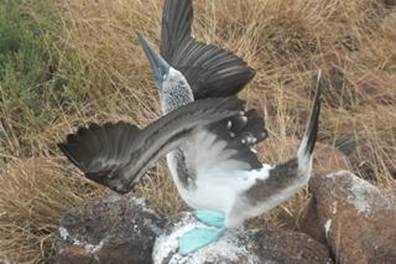
Just look at me!! I’m your
alpha male!

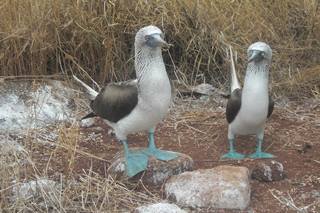
Girl, you ain’t seen dancin’ like this before
OK, ma’am; now let’s see you strut your stuff
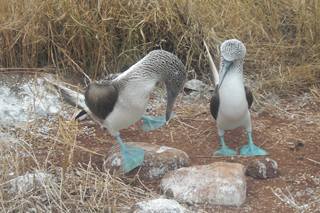
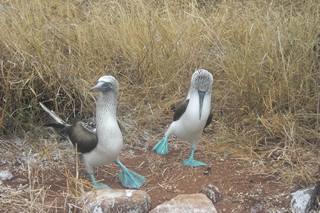
Oooh, y’know what? That
ain’t bad at all.
So, let’s boogie. The
blue-footed boobie pas de deux

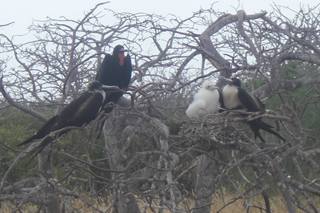
Hopeful Mr Frigate Bird awaits atop his nest
Frigate bird family.
Dad’s past impressing females.
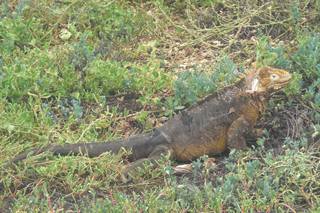
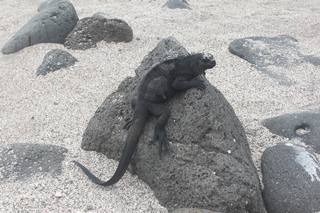
Land Iguana
Marine Iguana
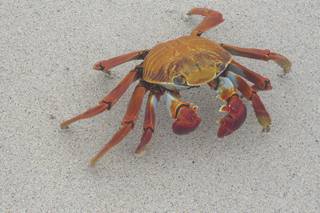
You lookin’ for a fight?
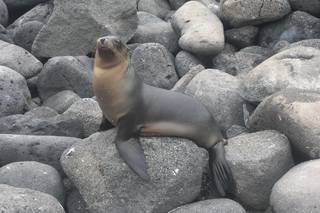
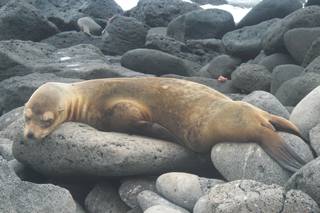
Am I handsome or what?
Actually, no . . . . .


you are a cheeky bundle of . . . . .
precocious adolescence.
We had
been warned that getting fuel was likely to be a complicated business. There is only one filling station on the
island and you can’t get fuel unless you have applied for and been given an
allocation by the Fuerza Naval. So
that was another form to acquire – though at least the agent did oblige this
time and there was no fee. We
needed 180 litres to replace what we’d used on the way to the Galapagos and we
had 6 twenty litre plastic jerry cans in which to collect it by taxi. So, it was a bit of a palaver and it
took a bit of time but t’was done.
Fuel there costs locals $1.02 per US
gallon whilst foreigners pay $4.80.
Still, that’s about $1.26 /£0.85 per litre so it could be
worse.
By
Friday 15th everything was dry enough to stow back on the boat. Fresh provisioning was completed, the
waterline was cleaned (even a few days in that anchorage had been enough to
leave huge amounts of slime and weed well above the waterline) and we made ready
to depart. The anchor was raised at
1730 and off the three of us set heading west – a long way.















